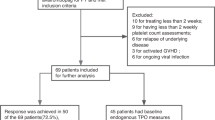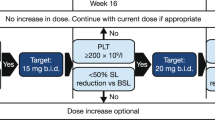Abstract
We report phase II trial results of the use of oral anagrelide hydrochloride for treating 38 patients with hydroxyurea (HU)-resistant thrombocytosis accompanying chronic myeloid leukemia (CML). Anagrelide's efficacy was well established during a phase II study of more than 400 patients with one of the four myeloproliferative disorders: essential thrombocythemia, polycythemia, idiopathic myelofibrosis, and CML. In the last subgroup, there were 114 CML patients with significant thrombocytosis treated with anagrelide. Out of these patients, 38 had symptoms of thrombosis or hemorrhage and had thrombocytosis resistant to HU. They were then treated with anagrelide at an initial dose of 2.0 mg/day, followed by modifications based upon response and toxicity. In all, 71% of these patients responded with platelet reductions of more than 50% in a median time of approximately 4 weeks. The response rate was not influenced by age, gender, or prior thrombosis or hemorrhage. Importantly, the response rate to anagrelide in patients refractory to prior HU was essentially the same as that of the other 76 CML patients. Treatment with anagrelide was well tolerated and without undue toxicity. Reduction of excessive platelet counts by anagrelide sometimes occurring in CML may lead to the prevention of thrombohemorrhagic complications occurring in this clinical setting and is relevant even in those patients in whom imatinib mesylate is primary therapy.
This is a preview of subscription content, access via your institution
Access options
Subscribe to this journal
Receive 12 print issues and online access
$259.00 per year
only $21.58 per issue
Buy this article
- Purchase on Springer Link
- Instant access to full article PDF
Prices may be subject to local taxes which are calculated during checkout

Similar content being viewed by others
References
Silver RT . Chronic myeloid leukemia. Curr Opin Oncol 1992; 4: 66–72.
Silver RT . Chronic myeloid leukemia. Hematol Oncol Clin North Am 2003; 17: 1159–1173.
Ravandi-Kashani F, Schafer AI . Microvascular disturbances, thrombosis, and bleeding in thrombocythemia: current concepts and perspectives. Semin Thromb Hemost 1997; 23: 479–488.
Michiels JJ . Erythromelalgia and vascular complications in polycythemia vera. Semin Thromb Hemost 1997; 23: 441–454.
van Genderen PJ, Michiels JJ . Erythromelalgia: a pathognomonic microvascular thrombotic complication in essential thrombocythemia and polycythemia vera. Semin Thromb Hemost 1997; 23: 357–363.
Barbui T, Cortelazzo S, Viero P, Bassan R, Dini E, Semeraro N . Thrombohaemorrhagic complications in 101 cases of myeloproliferative disorders: relationship to platelet number and function. Eur J Cancer Clin Oncol 1983; 19: 1593–1599.
Fenaux P, Simon M, Caulier MT, Lai JL, Goudemand J, Bauters F . Clinical course of essential thrombocythemia in 147 cases. Cancer 1990; 66: 549–556.
Cortelazzo S, Viero P, Finazzi G, D'Emilio A, Rodeghiero F, Barbui T . Incidence and risk factors for thrombotic complications in a historical cohort of 100 patients with essential thrombocythemia. J Clin Oncol 1990; 8: 556–562.
Wehmeier A, Daum I, Jamin H, Schneider W . Incidence and clinical risk factors for bleeding and thrombotic complications in myeloproliferative disorders. A retrospective analysis of 260 patients. Ann Hematol 1991; 63: 101–106.
Colombi M, Radaelli F, Zocchi L, Maiolo AT . Thrombotic and hemorrhagic complications in essential thrombocythemia. A retrospective study of 103 patients. Cancer 1991; 67: 2926–2930.
Trapp OM, Beykirch MK, Petrides PE . Anagrelide for treatment of patients with chronic myelogenous leukemia and a high platelet count. Blood Cells Mol Dis 1998; 24: 9–13.
Anagrelide Study Group. Anagrelide, a therapy for thrombocythemic states: experience in 577 patients. Am J Med 1992; 92: 69–76.
Best PJ, Daoud MS, Pittelkow MR, Petitt RM . Hydroxyurea-induced leg ulceration in 14 patients. Ann Intern Med 1998; 128: 29–32.
van Genderen PJ, Leenknegt H, Michiels JJ, Budde U . Acquired von Willebrand disease in myeloproliferative disorders. Leuk Lymphoma 1996; 22 (Suppl 1): 79–82.
Fruchtman SM, Petitt RM, Gilbert HS, Fiddler G, Lyne A, Anagrelide Study Group. Anagrelide: Analysis of long term safety and leukemogenic potential in myeloproliferative diseases (MPDs). Blood 2002; 100: 70a (abstr.).
Tsimberidou AM, Colburn DE, Welch MA, Cortes JE, Verstovsek S, O'Brien SM et al. Anagrelide and imatinib mesylate combination therapy in patients with chronic myeloproliferative disorders. Cancer Chemother Pharmacol 2003; 52: 229–234.
Fruchtman S, Pettit RM, Gilbert H . Anagrelide therapy significantly reduces disease related symptoms in patients with myeloproliferative disorders. Blood 2003; 102: 32a (abstr.).
O'Brien SG, Guilhot F, Larson RA, Gathmann I, Baccarani M, Cervantes F et al. Imatinib compared with interferon and low-dose cytarabine for newly diagnosed chronic-phase chronic myeloid leukemia. N Engl J Med 2003; 348: 994–1004.
Acknowledgements
I thank Frieda Pearce, PhD, and Ms Carmen Dixon for their assistance in the preparation of this manuscript. This study was supported in part by the United Leukemia Fund, Inc., and the Cancer Research and Treatment Fund, Inc.
Author information
Authors and Affiliations
Corresponding author
Rights and permissions
About this article
Cite this article
Silver, R. Anagrelide is effective in treating patients with hydroxyurea-resistant thrombocytosis in patients with chronic myeloid leukemia. Leukemia 19, 39–43 (2005). https://doi.org/10.1038/sj.leu.2403556
Received:
Accepted:
Published:
Issue Date:
DOI: https://doi.org/10.1038/sj.leu.2403556
Keywords
This article is cited by
-
Comparison of starting doses of anagrelide as a first-line therapy in patients with cytoreductive therapy-naïve essential thrombocythemia: difference between starting at 0.5 and 1.0 mg/day
International Journal of Hematology (2020)
-
A unified definition of clinical resistance/intolerance to hydroxyurea in essential thrombocythemia: results of a consensus process by an international working group
Leukemia (2007)



